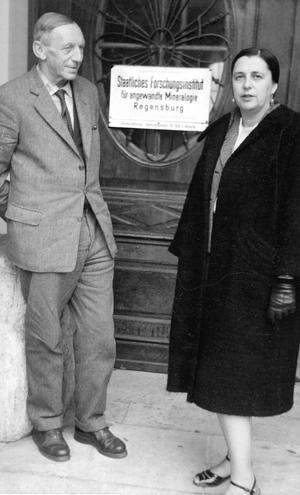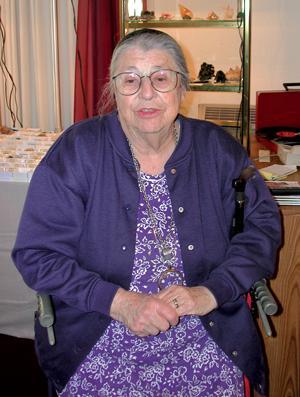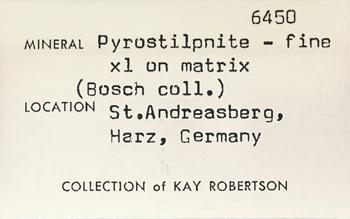Robertson, Kay (1920-2020 )
Kay Robertson was born Gabriella Katherine Loewi in Venice, Italy, on April 23, 1920, the daughter of Katherine Bernheimer and Adolf Loewi. Kay has been a major presence in the world of serious mineral collecting, both in the U.S. and Europe, since the mid-1950s, and now has a collection numbering about 13,000 specimens, including a sub-collection of minerals from Germany which is among the best such assemblages in private hands in the world.The venerable Bernheimer family of dealers in art and antiques, headquartered in Munich, had supplied works of art to European royalty, and served high-ranking families as interior designers and decorators. Kay's great-grandfather was once commissioned to build a throne for the British Viceroy of India. After serving periods of apprenticeship in New York and Madrid, Adolf Loewi formally entered his wife's family business in Munich in 1908, and in 1911 moved to Venice to set himself up as an independent art dealer, choosing as his headquarters a beautiful medieval building, once the Abbey of St. Gregory on the Grand Canal.
In 1923, Adolf Loewi became honorary German consul in Venice, and thus was inaugurated a busy, opulent decade from which Kay's earliest memories derive. She and her sisters went to a school for the children of the small colony of expatriate Germans in Venice; she recalls being dressed in laces and ribbons for formal entertainments, and wealthy art clients and diplomats coming through. At school Kay spoke German and at home she spoke both German and Italian. After school hours a succession of private teachers instructed the sisters in French and English, the other two of the four languages which Kay now speaks fluently.
Kay's mineral collection began in 1929 when her grandmother gave Kay her first mineral specimens on Easter Sunday, wrapped like Easter eggs. The specimens were from a "curio cabinet" that Kay's father and uncle had built in Munich during the previous century.
But in 1933, the first year of Nazi rule back in Germany, anti-semitism forced the girls to withdraw from the German school. Kay finished her formal schooling through an accelerated program of private lessons at home, and, during 1937-1938, in a finishing school for girls in Lausanne, Switzerland. As she had decided that she would soon enter her father's business in a "modern" and practical way, Kay took many elective courses at the Lausanne school, not only in art and design, but also in bookkeeping and business practice.
In June 1938, Kay began work as her father's secretary, doubling informally as a creative assistant in interior design. The following year they moved to New York to escape the Nazi invasion. Adolf had set up a New York branch office in 1933, which did good business, but the Loewis did not like New York, and by June 1939 they were already renting quarters in Beverly Hills, California. In December of that year they bought a large house above Sunset Strip, and Kay has remained, quite contentedly as she says, a Californian through all the decades since.
After the war years the business flourished; American museums and private collectors were buying art. From Europe, at various times, the Loewis had shipped or carried much stock—chiefly complete antique rooms (wainscotings), sculptures, and woven silks ranging in historical period from medieval to early 19th-century.
William J. Robertson, who served with distinction in the North Atlantic and Indian Ocean theaters during World War II, met Kay in September 1944, just after Kay had become a U.S. citizen, and on July 7, 1945, they were married in Victoria, British Columbia. After Bill's discharge from the service in 1946 they moved to Los Angeles, where Bill began an apprenticeship in Adolf Loewi's firm. Only one of Kay's three children, David John Robertson, survived to adulthood.
In 1970 Adolf Loewi retired, and Kay and Bill took over all business. During the 1970s and the first half of the 1980s the Robertsons very actively marketed furniture, paintings, and decorative objects, especially textiles; Kay was "on the road" all over the U.S. and Europe for much of this time. But after Bill died in 1986 a slow deceleration set in. Kay closed down the last of the business in 2003.
The first mineral show Kay attended was held in 1952 at the Shrine Auditorium. There she was especially impressed by an exhibit which the Santa Monica Gem and Mineral Society had mounted. She joined the organization and befriended two major mineral collectors, Verne Cadieux and Marion Godshaw. Godshaw did much to encourage Kay's interest in minerals and to learn more about mineralogy, as did mineral dealer Jean Hamel.
Kay developed a routine of regular visits to a mineral shop called "The Bradleys," and was taking her two then-living children along as she regularly looked in on the many small shows held around southern California on weekends. In 1955, the family traveled to San Francisco for the California Federation Show—Kay's first really large mineral event. She made a rule whereby she could not spend more than $35 on any single mineral specimen, and for the next 31 years she followed the rule without a slip. In 1986, after Bill died, she finally allowed herself to begin buying more expensive pieces.
For her first significant publication, Kay wrote an article on the Wölsendorf, Bavaria fluorite locality for the August 1963 issue of The Mineralogist. The Wölsendorf article was an early expression of the special interest in German minerals and German mineral localities which Kay began to develop in the late 1950s. In 1964, she undertook a four-week mineralogical tour of Germany—her first time in Europe since 1939, launching the building of a serious sub-collection of German minerals.
Kay also took up micromounting, and was a founding member of the Southern California Micromineralogists Society. The Hagendorf-Süd phosphate pegmatite, in the Upper Palatinate region of Bavaria, is Kay's favorite classic German locality, and the one best represented in her collection today.
From the mid-1960's onwards, Kay has continued to establish friendships with many eminent collectors and mineralogists. Pough's A Field Guide to Rocks and Minerals served as a central text in her early days of collecting. Following the founding of the Friends of Mineralogy (and the Mineralogical Record) in 1970, Kay served on FM's Board of Directors for many years, and eventually donated $1000 to endow a "Best Educational Case" award to be given each year by the Friends of Mineralogy at the Tucson Show.
When examined with any care, the Kay Robertson collection gives consistent evidence of its creator's refined taste, keen eye for aesthetics, and encyclopedic knowledge of major occurrences for every major mineral species and a great many rare ones: more than 1,300 species are represented in all. The labels are all thorough and clear, and many, many specimens are accompanied by backward progressions of earlier labels. Until recently, Kay's collection has been kept in myriad corners and cul-de-sacs and in cabinets along many walls of her small, lavishly cluttered, one-story house. However, she has finally come to the point in her life where she has decided to sell her collection; Rob Lavinsky (The Arkenstone) has taken over that task.
____________________________________
Click to images to view larger
To contribute more information please E-mail us at:
minrecord@comcast.net
Citation format for this entry:
WILSON, Wendell E. 2022
Mineralogical Record
Biographical Archive, at www.mineralogicalrecord.com
minrecord@comcast.net
Citation format for this entry:
WILSON, Wendell E. 2022
Mineralogical Record
Biographical Archive, at www.mineralogicalrecord.com
Kay Robertson with friend August Hartlaub in 1964, visiting the State Mineralogy Institute in Regensburg, Germany



